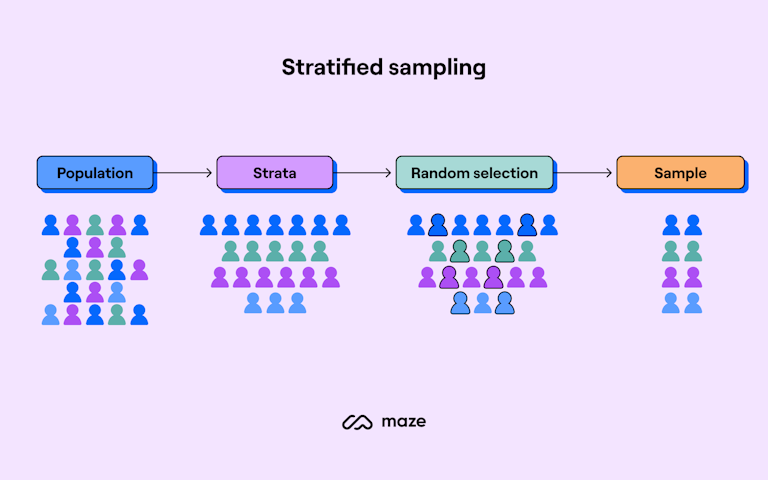TL;DR
Valid UX research ensures your insights reflect real user behavior. Strengthen research validity by asking neutral questions, using mixed methods, and recruiting diverse participants. Avoid common pitfalls like poor sampling, bias, and relying on a single data source to get research results your team can trust.
How can you be sure your UX research insights reflect real user behaviors, motivations, and habits?
Ultimately, it’s a question of ensuring your study accurately measures what it’s supposed to measure—aka research validity.
By strengthening validity in UX research, you can ensure that your findings are credible and trustworthy. Designing research projects with validity in mind ensures you get valuable, usable insights.
In this article, we show you how to ensure you collect valid findings for your next research study, along with solutions to the common validity challenges you may encounter along the way.
What is validity in user research, and why does it matter?
Validity in user research is the extent to which your UX research study accurately captures and reflects user behavior through specific methods and measurements. A valid study is credible and trustworthy. Ensuring validity in your research study leads to actionable user insights that align with your research objectives.
To ensure research validity, you’ll want to look at:
- What you’re measuring
- How you measure it
- The results (whether your study measures what you intended)
Research validity is a common counterpart of reliability, which looks at how consistently you can replicate your data collection method and get the same reliable results.
So why pay special attention to validity before embarking on an ambitious research project? The main benefits include:
- Gain credible insights: Reflect your users’ real behaviors, motivations, and experiences
- Align on clear goals: Connect your methods, measurements, and original research objectives
- Build stakeholder trust: Encourage them to back your initiatives and champion your insights in decision-making
- Design with confidence: Ground your decisions in valid, reliable research that drives impact, adoption, and user satisfaction
Types of validity in user research
Research validity can be put into two broad categories: internal and external validity.
Internal validity measures the level at which you derive results from the specific variables you’re testing, rather than external factors (also called confounding variables). It answers the question: “Did what I tested truly cause the result?”
Internal validity is:
- High: When there’s a cause-and-effect relationship between your testing factor and the result
- Low: When another external variable might have affected the result
External validity looks at how accurate your study would be beyond your sample size, with a focus on generalization in other settings, populations, and measures. It answers the question: “Do my findings apply to the real world?”
External validity is:
- High: When can you test your study with different groups and get similar results
- Low: When you can’t replicate your results in other contexts
How do these two main validity types play out in UX research?
High validity | Low validity | |
|---|---|---|
Internal validity | You run an A/B test where the only thing that changes is the button color | You run an A/B test where you change the button color, placement, and copy |
External validity | You run the A/B test with users from different countries, in their natural environment | You conduct the A/B test with five coworkers in a quiet office |
There are other important validity types as well:
- Face validity: How appropriate your chosen method and measurements appear for your research objective at first glance
- Criterion validity: How well your test measures a specific outcome that it was originally set out to measure
- Content validity: Whether the study represents all aspects of the topic you’re measuring
- Construct validity: Whether the method you’re using aligns with what you’re trying to measure
5 Methods to strengthen validity
Ensuring validity in research doesn’t mean you need to overhaul your entire UX research study. It just means taking a few extra steps to ensure your insights are credible and trustworthy.
Need to check for validity yesterday? Download our free checklist.
Here are five methods to help you strengthen your study’s validity.
1. Ask objective questions
Always ask neutral questions when conducting a survey questionnaire, usability test, or interview study. Your questions shouldn’t lead participants into answering in a specific way.
For example, the question, “Wasn’t that easy?” can influence participants to affirm, skewing results.
Instead, to mitigate bias, ask an objective, non-leading question like, “How easy or difficult did you find completing the task?”
Sticking to an objective line of questioning strengthens internal validity by reducing the risk of influencing participant responses.
💡 Questions that guide users towards a specific answer are called leading questions. Learn more about leading questions and how to avoid them.
2. Pilot test studies with your team
You may have your test all rehearsed and ready for launch. But that doesn’t guarantee a flawless session or valid results. Before conducting the real test, try it out with other members on your team. This can quickly uncover confusing tasks, unclear instructions, and inconsistent procedures early on.
For example, a pilot test might reveal that your interview questions are biased or that your task flow is too complex.
Run a pilot test study when you want to check for internal validity and limit mistakes that could skew your results.
3. Use mixed research methods
If you want your study to give you a high-resolution snapshot of user behaviors, consider testing the same set of participants with different qualitative and quantitative research methods.
For example, if you conduct a mixed research method project with user interviews followed by closed-ended surveys, you gain a combination of qualitative and quantitative insights.
If you get the same or similar results across different types of research methods, it indicates that your study is valid across a wide set of users and has statistical significance.
Using mixed research methods supports construct validity because it cross-references results via different methods. It also strengthens external validity because it demonstrates that you can get consistent results that hold up in both quantitative and qualitative research.
4. Recruit a diverse participant sample
While your participants should share the behaviors of your user persona, be sure to recruit testers with different demographics, devices, and geographic locations.
Recruiting a diverse participant sample ensures that your research is inclusive and your end product is accessible and helpful for ensuring external validity. Recruiting a diverse user base and getting the same results proves your findings are generalizable across use cases.
5. Connect user tasks to jobs-to-be-done
When conducting tests with users, make sure that the tasks and questions you give them directly relate to their goals and jobs-to-be-done. This ensures that the insights you receive are relevant to your study, and will be helpful when making design decisions.
For example, if you’re exploring how users interact with your budgeting app, ask them about the goals they set, how they fulfill them, and any other apps they use alongside yours. If you’re testing usability, frame tasks around your users’ needs, like “send a payment request and get paid.”
Connecting your testing questions to your users’ jobs-to-be-done gives you additional context and a better, wider, and deeper understanding of your user base, which strengthens content validity.
⚙️ Maze tip: No matter which of the methods you use, always share your findings and research plans with stakeholders. This is especially useful for ensuring face validity, by clarifying wording, filling gaps, or adjusting emphasis before finalizing the report.
3 Common validity pitfalls and how to avoid them
Ensuring validity in your UX research studies requires a proactive approach to potential challenges. Here are three roadblocks standing in the way of valid insights in your next UX research study.
1. Not using sampling strategies
Faced with tight deadlines, budgets, and resources, many researchers recruit the first testers they come across instead of finding people who match their real-world user base.
Failing or rushing the process of finding and vetting the right research participants is a huge mistake; when you recruit the wrong testers, your user insights can be false or skewed, which raises questions about your research validity.
One way to avoid this problem is to use a recruitment tool like Maze Panel, which gives you access to over 3 million vetted testers across 130+ countries.
Consider also using stratified sampling to find a diverse set of participants. This sampling technique involves dividing potential participants into subgroups, or “strata,” based on demographic information such as age, education, income, or employment. You then choose participants from each stratum at random to participate in your test. This ensures that your user base is diverse, providing you with valid insights.

Once you’ve recruited your research participants—whether with Maze or without—manage them in Maze Reach. This purpose-built research participant management platform helps you organize participants and studies to streamline your workflow.
2. Subjective bias influencing data
Bias is when personal leanings, yours or the participants’, skew your study’s data and, in turn, the insights you draw from it.
When bias creeps in, your feedback becomes unreliable, derailing your path to relevant findings.
Types of bias in UX research to be aware of:
- Leading questions: Asking questions that prompt or “lead” participants to a specific answer. Mitigate this by double-checking your questions for objectivity.
- Confirmation bias: When you seek out and overemphasize data that confirms your own beliefs. Mitigate this bias by performing data analysis.
- Hawthorne effect: Participants change their behavior when they know they’re being observed. Mitigate this bias by using unmoderated research methods alongside moderated ones.
- Social desirability bias: Participants give answers they think are acceptable or pleasing to the moderator, rather than being honest. Mitigate this bias by assuring participants that there are no wrong answers before asking questions.
3. Overreliance on a single metric
User research gives you a wealth of user data and insights that you can apply to product development and design. But drawing conclusions from a single data source can jeopardize your study’s validity; participants might say one thing in interviews, but behave differently during a usability test.
The best way to overcome this challenge is to use mixed research methods, and introduce data triangulation into your UX workflow. Data triangulation combines multiple data types, sources, and methods in order to strengthen validity. For example, interviews could work in hand with prototype testing, while In-Product Prompts can be coupled with heatmaps.
Once you have results from each research method, cross-check your findings for accuracy. If you’re conducting usability tests, be sure to include multiple metrics—like task success rate or time on task. If you’re running a set of surveys or interviews, ask a wide range of question types, including open-ended, closed-ended, and multiple-choice, and use Likert scales.
⚙️ No time for managing multiple research methods? Maze’s AI moderator lets you scale automated interviews, giving you in-depth, rich, and descriptive insights whenever you need them.
Putting validity into practice with Maze
Research validity shows how accurately your research reflects real user insights. By ensuring validity through methods like asking objective questions, pilot testing, and using mixed-method research, you can rest assured that your design decisions are rooted in real user behaviors. Besides credible insights, paying attention to validity means you can create a connection between your methods, measurements, and original research goals.
To ensure your insights are valid, we recommend using a tool like Maze. From running pilot studies with your team to conducting mixed-methods research, you can use Maze to streamline valid, reliable insights for your next project.
Frequently asked questions about validity in user research
What does validity mean in user research?
What does validity mean in user research?
Validity in user research means ensuring your study accurately reflects real user behaviors. A valid study uses the right methods and measurements, making the insights you gather credible and trustworthy.
How is validity different from reliability in UX research?
How is validity different from reliability in UX research?
Validity in UX research is about how well the insights you gather reflect user behavior through measurement. Reliability looks at how consistently you achieve similar, reliable results when conducting your research.
What are the main types of validity in research?
What are the main types of validity in research?
The main types of validity in research include:
- Internal validity
- External validity
- Face validity
- Criterion validity
- Content validity
- Construct validity
How can I improve validity in my research studies?
How can I improve validity in my research studies?
You can improve the validity of your UX research study through various methods, such as:
- Asking objective research questions to mitigate bias
- Pilot testing studies with your team
- Using mixed research methodologies
- Recruiting a diverse participant sample
- Studying the entire user experience for a single subject
Why is validity important for UX and product research?
Why is validity important for UX and product research?
Validity is important for UX and product research because it ensures the trustworthiness of your insights. It helps you avoid making costly design decisions based on research findings and study results that don’t represent your respondents’ behaviors and attitudes. The importance of validity is that it ensures a credible research design and reliable measurement.







